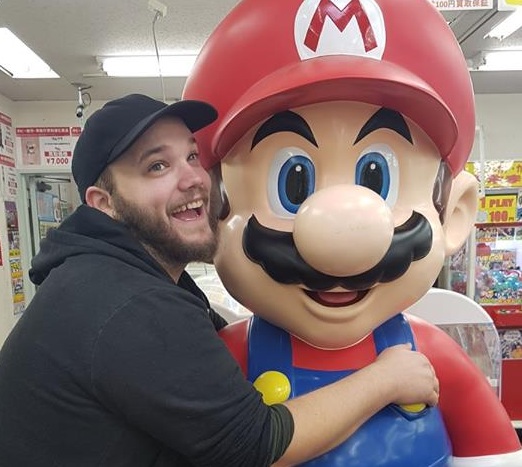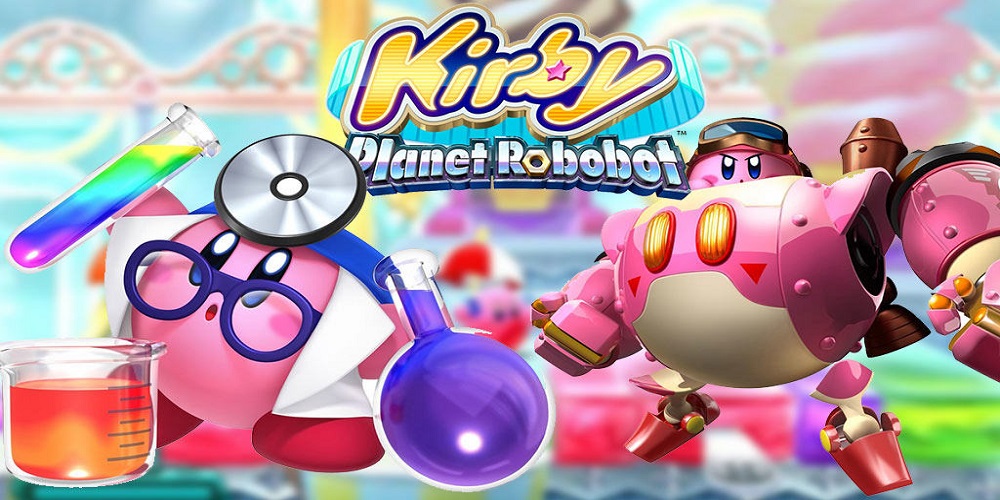
I find Kirby to be a terrifying being in himself (though that’s a topic for another article) but I still love the little guy, and I generally enjoy his starring titles. Kirby’s a pretty versatile character, with his games ranging from side-scrolling platform-puzzlers to soaring across the skies in weird racers like Kirby Air Ride. Of late, however, things have felt a little stale with the series, and I didn’t really enjoy the previous instalment of Kirby and the Rainbow Curse. Kirby: Planet Robobot tries to ensnare the side-scrolling roots that made the series what it is today, but still seems to be relying heavily on a central gimmick. It could have been great, it really could have, but as it stands it’s just sort of average and weirdly shows more potential in some of the mini-games than the main game itself.

Strike–… Wait, what we up to now, Nintendo, like, strike 15? Ugh.
The motivations of Kirby, an all-powerful being the defies the laws of physics and nature, have always struck me as being kind of disturbing and narcissistic. Sure, you could say that he sees what’s happening and rushes in to save the day, but previous games have seen him wreak absolute devastation across Dreamland because someone stole his cake. Kirby: Planet Robobot starts out with a gargantuan spaceship descending upon planet pop-star, drilling it’s way into the surface with enormous, spider-like arms, embedding itself as a semi-permanent feature of the planet. This ship then begins mechanising the landscape and anything on it, “enhancing” all it touches with machinery like some kind of cutesy Nintendo version of the Borg.
The Halberd, Metaknight’s giant flying ship, is almost immediately shot down, and King Dedede’s castle is obliterated with lasers, with the resulting commotion disturbing Kirby from his nap. This is when he gets up and runs off to save the day or, at the very least, remove the disturbance to his slumber. It seems that he’ll only ever get involved in preventing various apocalypses (apocolypsi?) for personal and petty reasons, and being abruptly woken is Robobot’s. I can appreciate that they’ve kept Kirby as the bizarrely self-centered little crime of nature that he is because it’s a shtick I don’t think will ever get old. The intro and overall concept are also really great ideas that are never fully realised in the rest of the game.
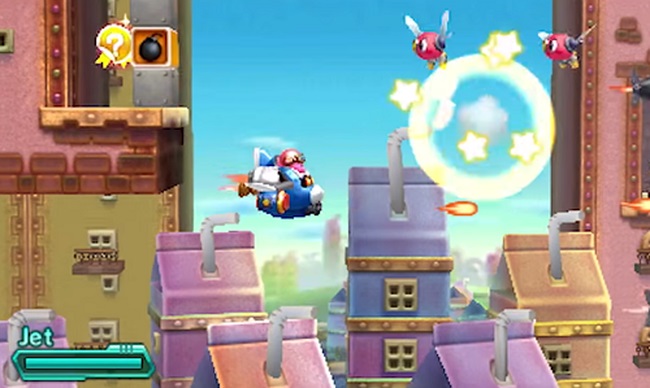
Kirby’s trademark cry of “Hiiiii!” should send shivers down the spine of any villain.
There’s nothing overly unique or fantastic to Planet Robobot’s design, it’s a side-scrolling platformer just like a large number of entries in the series. Like most other entries in the series, however, it has a “gimmick” that at least tries to make it stand out as something more than just another Kirby clone. Planet Robobot’s gimmick is that most of the levels involve piloting a huge freaking mech that’s been modelled on Kirby’s appearance (hereafter referred to as the Kirby Mech.) It can still absorb enemy powers, ratchet huge parts of the stage, or just ruin the day of everything around it and every instance of its use was a lot of fun. It breaks a lot of the standard Kirby rules – sometimes quite literally – with what it’s capable of, it’s just a shame that it didn’t have as significant a role as the title and cover suggest.
A good deal of the puzzles solely relate to the optional collectables (all of which, of course, I obsessively pursued) and involve the use of the Kirby Mech. Much like a lot of other aspects of Planet Robobot, however, it also feels like it’s just been randomly placed around the game without any thought as to how it would feel regarding gameplay. It isn’t even often that the Kirby Mech is required to pass a level, and there are more than a few levels that don’t involve its use at all. It’s almost like they created this awesome mechanic to base the whole game around and then plum forgot to use it before randomly shoving it into places towards the end of development. Even the few levels that flat out require it to be used seem to fall short of seeing this mechanic used to its full potential.
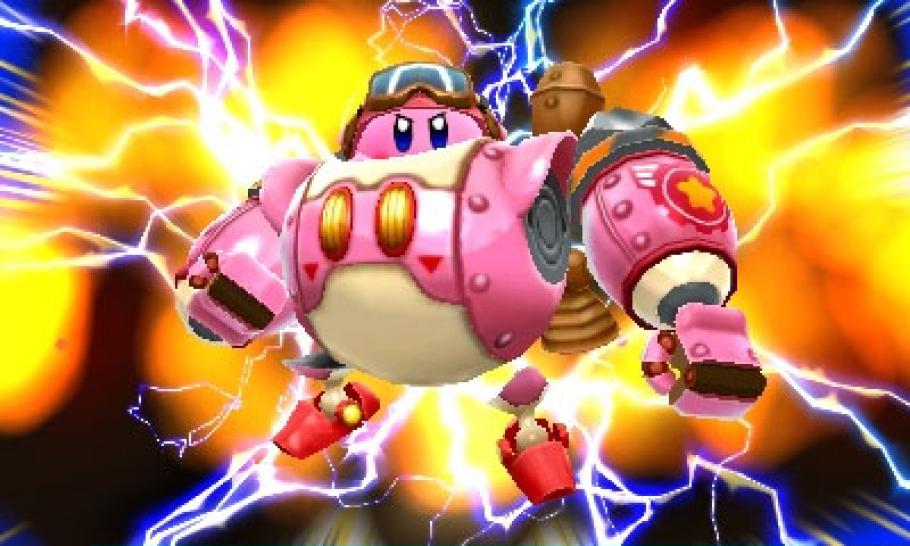
“The Kirby Mech? Yeah, yeah, we’ll get around to– oh shit, is it March already?” – HAL Laboratories, probably.
One example would be the side-scrolling SHMUP levels; when absorbing a jet-pack enemy, it turns the Kirby Mech into a flying ship that you control like the game just became G-Darius. The first time I played one of these levels I thought it was fantastic and was an excellent departure from the standard gameplay, and even had a bullet-hell-lite boss at the end. The second time felt a little less exciting as it was a lot of the same, including the same end-boss but with an added, lacklustre form to beat. The third time around was boring as hell and didn’t even throw in an end-of-level boss. Basically, what I’m saying is that if they weren’t going to feature the Kirby Mech as prominently or with a modicum of variety as it was suggested they would, then there should have been something else. Anything else, besides the standard Kirby gameplay we’ve all played dozens of times before.
Of course, it wouldn’t be much of a Kirby game if the single-player campaign was all there was to it. There are two mini-games (Kirby 3D rumble and Team Kirby Clash) accessible from the start and two more unlockable modes for completing the single-player mode: MetaKnightmare Returns and a boss-rush mode. One of the mini-games was clearly a throw-away idea, basically a time and combo attack mode for knocking off enemies on a 3D plane, and the boss-rush mode was… Well, it’s a boss-rush mode. On the other hand, in a lot of ways, I enjoyed MetaKnightmare Returns and Team Kirby Clash more than I did the primary single-player mode. It’s not a good sign when the side-content outshines the main feature, but let me explain why I think it felt this way.
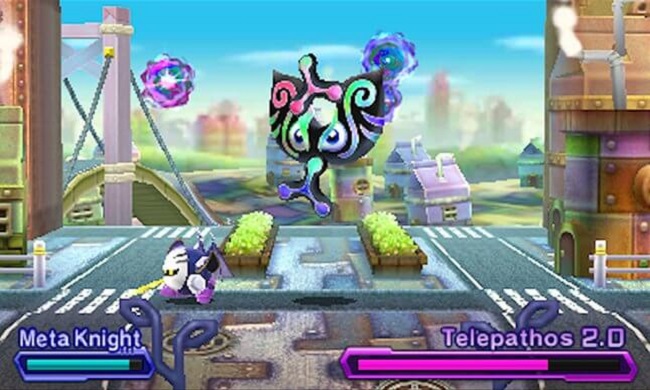
He says, as though “playing as Meta Knight” and “Kirby RPG” aren’t self-explanatorily rad.
MetaKnightmare is a speed-run of the main game while playing as Meta Knight, using selected, slimmed-down versions of various levels of the single-player mode. Meta Knight has the same level of destructive power of the Kirby Mech and, while he can’t ability-copy like Kirby can, he has his own innate abilities that are used by accruing power while playing. The Team Kirby Clash was almost like a mini-Kirby RPG, with four classes to choose from, that pitted you and a team of other Kirby’s against a series of bosses, and it was awesome. The bosses were varied enough in their tactics to keep things interesting for a mini-game and the classes actually had proper roles to play within a full team. HAL? Take note – both of these modes were more fun than the main game and would make excellent games in the own right if they were properly expanded upon. I have expecations now.
It’s hard to criticise the gameplay of a Kirby game, especially one that encapsulates the traditional spirit of the series almost formulaically, but damned if I’m not going to try. Rarely is it difficult, and even the few moments that might be described as such are the results of having let my guard down before being taken by surprise. This is pretty typical of Kirby games and something I’ve come to expect from the series, it just means that the difficulty or challenging angle has been removed entirely from the equation. That doesn’t mean there’s anything inherently wrong with the gameplay itself – the biggest problem the game had was maintaining player interest through how it was presented. For lack of a better term, the sequence of levels and how you approached them felt like a random lottery of what you’d get, and not by way of design.
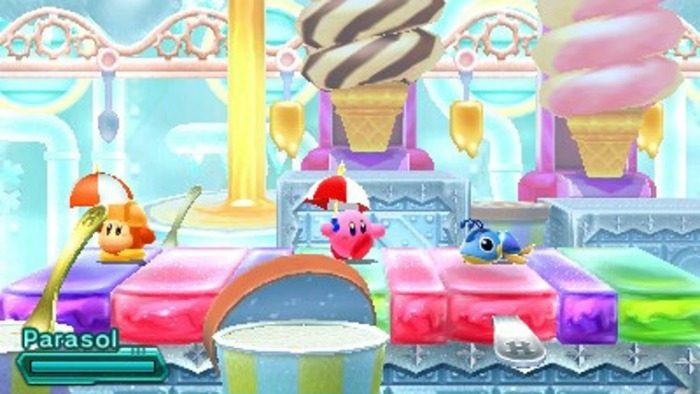
Rather, more like a lack of design direction. Or any direction at all. Seriously, was someone actually directing this game or did it just sort of “happen”?
The primary difference between each “world” is what appears as the backdrop to the actual gameplay. The levels themselves could otherwise be broken down into city levels, casino levels, construction site levels, water levels, and misc. They could have grouped these level types together, building upon a consistent theme for each world, and making them progressively better by increasing the difficulty as you progressed. Overload Ocean even has Ocean in its damn name, so why am I playing water levels outside of it? Rhythm Route looks like some kind of Vegas rip-off, why weren’t all the casino levels in there? It’s actually more boring to play the same sets of levels over and over than to play a world with only one level type that improves upon puzzles, challenges, and mechanics as you progress through it.
A lot of the classic enemies returned for Planet Robobot and, faithful to the theme of the game, a few received something of a make-over to create new, mechanised versions of monsters we might be familiar with. In a lot of instances, however, most of the classic enemies are almost exactly as you’ll remember them and stand out for the wrong reasons. There’s also a lack of consistency in the visual design for levels in each world, as mentioned before. Every area having what felt like “one of each level type,” was kind of boring – the casino levels, for instance, were mostly pretty fun and brought with them something I hadn’t seen before in a Kirby game. Their impact was lost, however, when there was one per world, and they all looked and played mostly the same. Like most of the Planet Robobot, it feels like everything was created separately and then just scrambled together instead of having a sense of direction, or thought put into how it should all fit together.
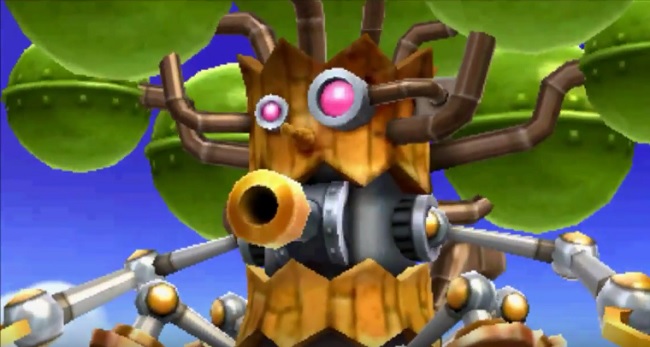
Admittedly, some of the conversions look pretty dang neat.
I don’t normally have a lot to say about the audio-visual aspect of games unless they’re strikingly good or horrifically bad, but neither is the case in Planet Robobot. As a testament to both the series’ consistency, and Planet Robobot’s own ironic lack of imagination, both are typically Kirby, and I guess it’s up to you as to whether or not that’s a bad thing. If you were to take a random screenshot from the game and remove all the visible enemies and HUD, there’s a decent chance that it could still be pegged as being a Kirby title. Some of the music followed a fitting electronica vibe, even occasionally remixing some classic tracks; however, it usually felt out of place for what was happening at the time. Some might say that this is good, that Kirby has an instantly recognisable style and that such a thing shouldn’t be knocked. Perhaps it’s just me, but I felt that I was just playing the same old stuff by the end of the game and nothing stood out as particularly interesting.
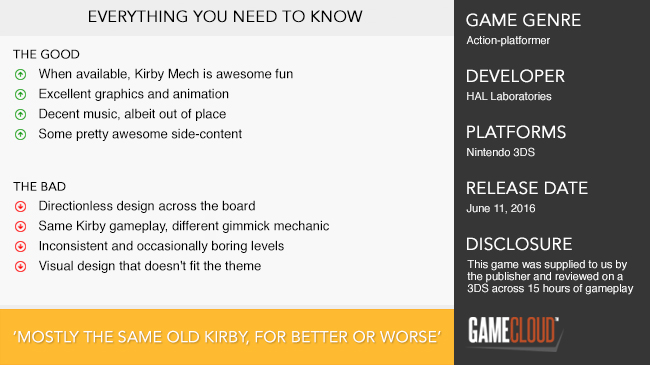
I know that Kirby is ostensibly a children’s series, and so we’ll never get a truly dark Kirby game, but the story behind Robobot started off strong and promising before falling pretty flat. Its influence is just barely squeezed into gameplay, level, and visual design, and the main gimmick-mechanic, despite still being enjoyable, isn’t used nearly as much as it should have been. The worlds felt like they were cobbled together as sets of each level type, instead of following a consistent theme and building upon established ideas, puzzles, and mechanics. I had more fun with the mini-games, which showed more promise and potential as full-scale titles than Planet Robobot’s primary campaign mode. If you’re a die-hard Kirby fan, you’ll still likely be onboard for a great time; if you’re expecting something really new and unique though then you’re in for a disappointment. I mean Jesus, HAL, this isn’t exactly your first foray into the Kirby series – what are you doing over there? Take your idea from the Team Kirby Clash mini-game and turn THAT into an excellent full-scale title, then get back to me. Either that or get onto Air Ride 2 because I have been waiting for that since 2004.

